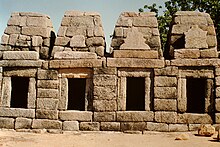Chausath Yogini Temple, Khajuraho
| Chausath Yogini temple | |
|---|---|
Chausath Yogini Mandir | |
 | |
| Religion | |
| Affiliation | Tantra |
| District | Chhatarpur |
| Deity | Devi |
| Location | |
| Location | Khajuraho |
| State | Madhya Pradesh |
| Country | India |
| Geographic coordinates | 24°50′58″N 79°55′05″E / 24.8495199°N 79.9181333°E |
| Architecture | |
| Date established | 9th century CE |
The Chausath Yogini temple is a ruined Yogini temple in the Khajuraho town of Madhya Pradesh, India. Dated to the late 9th century, it is the oldest surviving temple at Khajuraho. Unlike the Yogini temples at other places, it has a rectangular plan, but like them it is hypaethral, open to the air. As part of the Khajuraho Group of Monuments, and because of its unique Chandela architecture, the temple was inscribed on the UNESCO World Heritage List in 1986.[1]
History[edit]
The construction of the Khajuraho Yogini temple can be dated to approximately 885 CE.[2] It is the earliest extant temple at the Chandela capital, Khajuraho.[3] The temple has been classified as a Monument of National Importance by the Archaeological Survey of India.[4]
Ruins of Yogini temples have been found at other places in and around the territory formerly ruled by the Chandelas or their feudatories, including Badoh, Bhedaghat Dudahi, Lokhari, Hinglajgarh, Mitaoli, Nareshwar, and Rikhiyan. This suggests that the cult of the Yoginis was well-established in the Chandela territory. The Chausath Yogini temples are connected to the Kapalika and Kaula sects.[5]
Architecture[edit]


The temple is among the Western group of temples on a 5.4 m high platform.[6] It has a rectangular plan measuring 31.4 m x 18.3 m.[6][3] It is one of the historic Yogini temples across India; many of the others have a circular plan,[7] though those at Rikhiyan and Badoh are also rectangular, so there was at least a local tradition of building them in this shape.[8] Like all Yogini temples, the Khajuraho temple is hypaethral, open to the air.[9]
The temple is made of large, coarse granite blocks, with an open courtyard at the centre. The courtyard was originally surrounded by 65 shrine cells: 10 on the front (north) wall, 11 on the back wall, and 22 on each side. Only 35 of these 65 cells now survive;[3] each has a small doorway made of two squared granite pillars and a lintel stone, and a curvilinear tower roof. Above the lintel of the best-surviving cells is a triangular pediment. There is no surviving trace of a central shrine, whether to Shiva or the Goddess, as found in other Yogini temples.[4][9][6][8]
Apart from a single much larger cell for the deity, each of the 64 cells for yoginis is approximately 1 m high and 1 m deep. The large cell is located at the centre of the back wall, and faces the entrance at the north. It was probably a shrine of Durga. The other 64 ("Chausath") cells presumably housed the statues of yoginis.[3]
Sculpture[edit]
No sculptures remain among the temple ruins. Three large statues of mother goddesses or Matrikas, found among the ruins, are now in the Khajuraho museum.[3] The goddesses have been identified as Brahmani, Maheshvari, and Hingalaja or Mahishamardini. The image of Brahmani has three faces; her vehicle is a hamsa (swan or goose). Maheshvari is depicted with a trident and a humped bull. The image of Mahishamardini has one foot on a buffalo that she has defeated; she is holding its legs, and in two of her eight arms she wields a sword and shield.[8] These statues are among the oldest sculptures of Khajuraho.[6]
References[edit]
- ^ "Khajuraho Group of Monuments". UNESCO World Heritage Centre. United Nations Educational Scientific and Cultural Organization. Retrieved 25 June 2023.
- ^ Rana P. B. Singh 2009, p. 58.
- ^ a b c d e Ali Javid & Tabassum Javeed 2008, p. 201.
- ^ a b ASI MP List 2016.
- ^ Manohar Laxman Varadpande 1987, p. 291.
- ^ a b c d ASI Bhopal Chausath 2016.
- ^ Shobita Punja 2010, p. 39.
- ^ a b c Vidya_Dehejia 1986, pp. 115–117.
- ^ a b Shaman Hatley 2007, pp. 114–115.
Bibliography[edit]
- "Chausath Yogini Temple". Archaeological Survey of India, Bhopal Circle. Retrieved 16 November 2016.
- "Alphabetical List of Monuments - Madhya Pradesh". Archaeological Survey of India, Bhopal Circle. Archived from the original on 2 November 2016. Retrieved 16 November 2016.
- Vidya Dehejia (1986). Yogini Cult and Temples: A Tantric Tradition. National Museum, Janpath, New Delhi.
- Ali Javid; Tabassum Javeed (2008). World Heritage Monuments and Related Edifices in India. Algora. ISBN 978-0-87586-482-2.
- Shaman Hatley (2007). The Brahmayāmalatantra and Early Śaiva Cult of Yoginīs. University of Pennsylvania (PhD Thesis, UMI Number: 3292099).
- Shobita Punja (14 October 2010). Khajuraho: The First Thousand Years. Penguin. ISBN 978-93-85890-40-6.
- Rana P. B. Singh (2009). Cosmic Order and Cultural Astronomy. Cambridge Scholars. ISBN 9781443816076.
- Manohar Laxman Varadpande (1987). History of Indian Theatre: Classical theatre. Abhinav. ISBN 978-81-7017-430-1.


